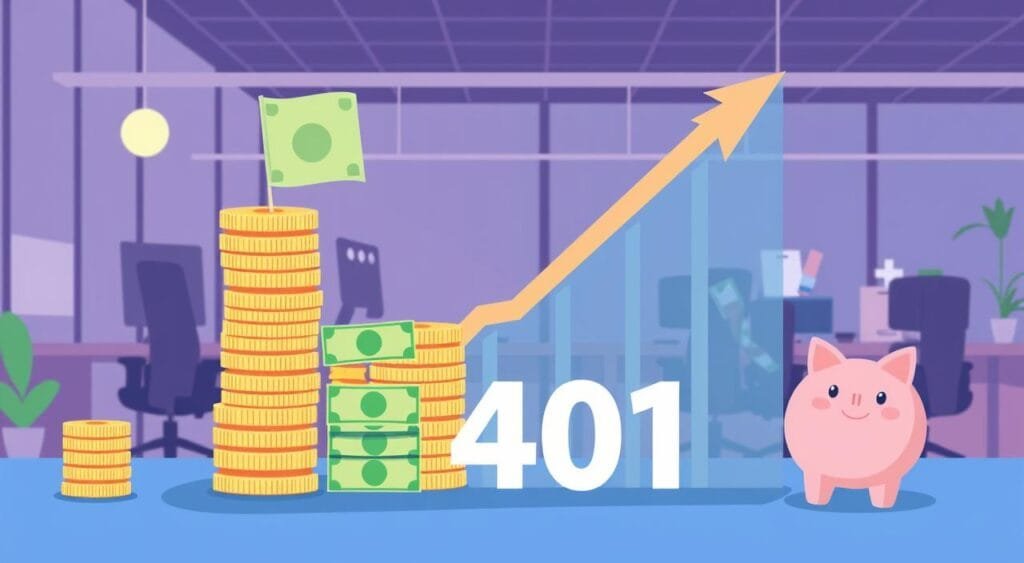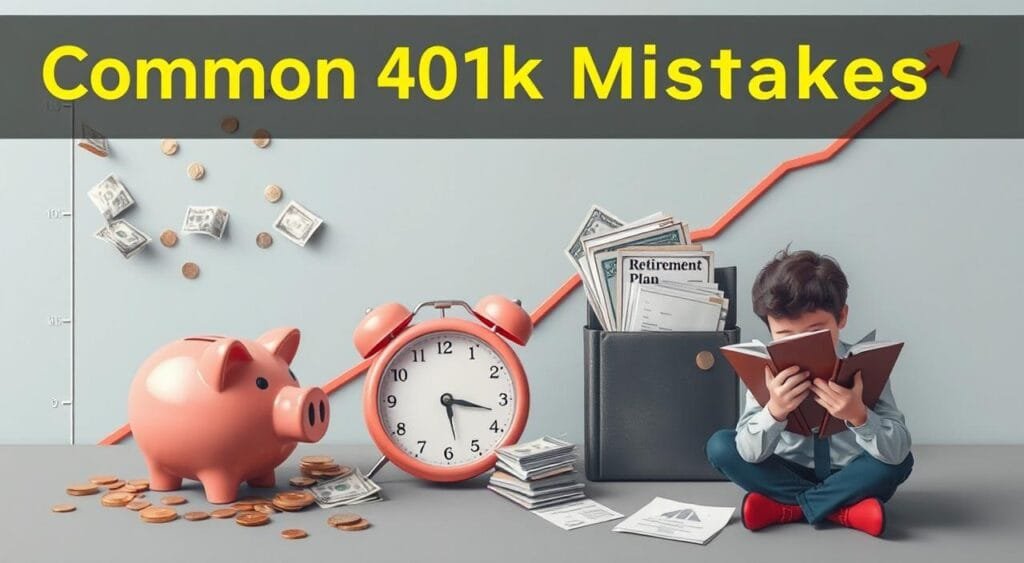Imagine you’re at a crossroads in your career, looking towards retirement. The journey ahead seems long and unsure. But, you have a powerful tool – your 401k. It’s more than just numbers; it’s your key to a secure future. Let’s start exploring how to make the most of your retirement savings.
Retirement may seem far off, but your choices now will shape your future. Did you know that while many workers have a 401k, only half put in over 10% of their income? This gap is your chance to stand out. It’s not just about being part of the group; it’s about leading in securing your financial future.
Your 401k is a powerful tool for tax-advantaged investing. Every dollar you add is a step towards a better retirement. The impact of your choices can be huge. For example, adding just 1% to your contribution could mean a bigger retirement fund.
Time is on your side. Starting early and putting more into your 401k can lead to a comfortable retirement sooner. It’s about making your money work hard, using employer matches, and the power of compound interest.
We’ll look at ways to increase your contributions, understand tax benefits, and balance your 401k with other financial goals. Whether you’re starting or boosting your plan, this guide is your roadmap to 401k success. Let’s make your retirement dreams a reality, one smart move at a time.
Key Takeaways
- Only half of 401k participants contribute over 10% of their salary
- Increasing contributions by 1% can significantly impact retirement savings
- Early maximization of 401k contributions can lead to earlier retirement
- Employer matches can substantially boost retirement savings
- Balancing 401k contributions with other financial goals is crucial
- Tax advantages of 401k plans enhance long-term savings growth
- Regular review and adjustment of your 401k strategy is essential
Understanding the Basics of 401k Plans

A 401k is a key tool for saving for retirement. It’s an employer-sponsored plan that lets you invest before taxes. This means your money grows without being taxed right away, helping you save for the future.
What is a 401k?
A 401k is a plan to help you save for retirement. You can set aside part of your paycheck before taxes. This reduces your taxes now and can lead to big growth over time.
How 401k Plans Work
When you join a 401k, you decide how much to save from each paycheck. Many employers add extra money to your account, essentially giving you free money for retirement. For instance, if you make $40,000 a year and save 3%, you’ll save $51,600 over 43 years. With an employer match, that could jump to $103,200.
Types of 401k Plans
There are two main kinds of 401k plans:
- Traditional 401k: You contribute with pre-tax dollars, which lowers your taxes now.
- Roth 401k: You contribute with after-tax dollars, but you won’t pay taxes on withdrawals later.
Both plans have their own benefits for saving for retirement. It’s important to think about your risk level, age, and retirement plans when picking investments. Looking at different funds can help you make a portfolio that fits your goals.
“Starting to save for retirement early can significantly impact savings over time. Delaying contributions can result in almost 20% less saved by retirement age.”
Maximizing your 401k contributions and using employer matches can set you up for a secure financial future. The secret to good retirement planning is saving regularly and investing wisely over time.
The Importance of Maximizing Your 401k Contribution

Putting more money into your 401k is a great way to save for retirement. The IRS sets limits for 2024 at $23,000 for those under 50 and $30,500 for those over 50. These limits offer big chances for tax-advantaged investing.
A good rule is to save 15% of your income for retirement. Start by adding 10% to your 401k and increase it by 1-2% each year as your salary goes up. This way, your savings grow without hurting your current lifestyle.
The effect of compound growth in your 401k is huge. For instance, putting in the max $23,000 a year for 10 years with an 8% growth rate could make your balance about $326,000. If you put in half that, it would be around $163,000.
“The suggested total savings needed for retirement is 25-30 times your desired annual spending.”
Many 401k plans let you choose a Roth option, using after-tax dollars. This gives you tax benefits in retirement. Employers often match your contributions, usually 50% of the first 6%. It’s key to take full advantage of this match to boost your retirement savings.
- Consistently contribute through automated deductions
- Review and adjust contributions annually
- Use calculator tools provided by your 401k plan to track progress
- Consider your individual lifestyle and income needs when planning
Maximizing your 401k contributions means you’re preparing for a more secure financial future. Remember, retirement planning should fit your unique needs and goals.
Current 401k Contribution Limits

Knowing the max you can put into your 401k is key for planning your retirement. The IRS updates these limits often to help people save more for later.
Annual contribution limits for 2023 and 2024
In 2023, you can put up to $22,500 into your 401k. This goes up to $23,000 in 2024. The total you can put in, including what your employer adds, is $66,000 in 2023 and $69,000 in 2024. Remember, these limits cover both traditional and Roth 401k plans.
Catch-up contributions for those 50 and older
If you’re 50 or older, catch-up contributions let you save more for retirement. For 2023 and 2024, you can add an extra $7,500 to your savings. This means you could save up to $30,000 in 2023 and $30,500 in 2024.
Experts say try to save at least 15% of your income for retirement, including what your employer adds. To make the most of your 401k, think about these tips:
- Contribute early in the year
- Take full advantage of employer matches
- Gradually increase your contributions
- Keep track of all active 401k accounts
Going over these limits can lead to penalties. It’s important to watch your contributions closely. Also, talk to a financial advisor to make the best plan for your retirement savings.
Strategies for Increasing Your 401k Contribution

Boosting your retirement savings through your 401k is key for a secure future. In 2024, those under 50 can put in up to $23,000, and those 50 and older can put in $30,500. To make the most of these limits, try these strategies.
Gradually upping your contributions is a good way to grow your savings. Try to increase your contribution rate by 1% each year. Many plans have an auto-escalation feature that makes this easy. When you get a raise, put some of it into your 401k.
Budgeting helps free up money for retirement. Look over your spending and see where you can cut back. Even small savings can grow big over time when put into your 401k.
- Set up automatic contributions to ensure consistent savings
- Take advantage of employer matches, typically ranging from 3% to 6% of salary
- Consider additional retirement accounts like IRAs for diversification
The average savings for retirement is 10% to 15% of your salary. Maximizing your 401k contributions is a smart move to hit this goal. By using these strategies and checking your plan often, you’ll be set for a comfy retirement.
401k Contribution: Maximizing Employer Match

Employer matching in 401k plans is a great way to boost your retirement savings. The average match is 4.6% of your pay, with a median of 4.0%. It’s important to know your company’s matching policy to make the most of this benefit.
Understanding Your Employer’s Matching Policy
Employer match programs can vary a lot. A common setup is $0.50 per dollar on the first 6% of your pay. Some companies offer dollar-for-dollar matches up to a certain percentage. Make sure to check your plan details to understand your employer’s offer.
Also, remember that employer matches often have a vesting schedule. This means you might not fully own the matched funds right away. The average vesting period is five years, according to the Bureau of Labor Statistics.
Calculating the Optimal Contribution
To get the most from your employer match, contribute enough to get the full match. This is essentially free money for your retirement. For example, if your employer matches 50% of your contributions up to 6% of your salary, aim to contribute at least 6% to get the full match.
Remember, employer matching contributions don’t count towards your personal contribution. In 2024, you can contribute up to $23,000 to your 401k, or $30,500 if you’re 50 or older, thanks to catch-up contributions.
- Review your employer’s matching policy
- Calculate the minimum contribution needed for full match
- Consider the vesting schedule
- Aim to maximize the free money from your employer
By understanding and making the most of your employer match, you’re taking a big step towards a secure retirement. It’s a powerful tool to grow your retirement savings faster and more efficiently.
Tax Benefits of Maximizing Your 401k

Maximizing your 401k contributions has big tax perks. By putting money into your 401k, you’re doing tax-advantaged investing. This can save you a lot of money over time. Let’s look at the main tax benefits:
One big plus is tax-deferred growth. Your money grows without being taxed until you take it out. This means you could have more money saved for retirement. It lets your money grow more over the years.
Putting money into a 401k also lowers your taxable income. For 2024, you can put up to $23,000 into your 401k. This reduces your taxable income. It could put you in a lower tax bracket and lower your taxes.
“Increasing retirement contributions by just 1% of your annual salary can result in tens of thousands of dollars more in your retirement account by the time you retire.”
For those 50 and older, there’s an extra tax perk. In 2024, you can add an extra $7,500, making your total $30,500. This is a great chance to increase your retirement savings and get tax benefits.
- Reduced current tax liability
- Potential for higher compound growth
- Tax-deferred earnings until withdrawal
- Opportunity for catch-up contributions
By maxing out your 401k, you’re securing your financial future and improving your tax situation. It’s a smart way to grow your wealth and cut your taxes.
Balancing 401k Contributions with Other Financial Goals

Maximizing your 401k is key, but it’s not the only thing to think about. You should also focus on saving for emergencies and managing your debts. This balanced approach helps you plan for the future better.
Emergency Fund Considerations
First, save for emergencies before filling up your 401k. Try to save 3-6 months of expenses in an easy-to-get account. This fund helps you avoid financial surprises and keeps you from using retirement savings too soon.
Debt Repayment Strategies
High-interest debt can stop you from reaching your financial goals. Pay off credit cards and personal loans first, but keep contributing to your 401k. After you’re debt-free, put more money into your retirement savings.
Short-term Savings Goals
Don’t forget about saving for things like a house down payment or your kid’s college. Balance these goals with your retirement savings. Use separate savings accounts for each goal to keep track of your progress.
Having a full financial plan covers all parts of your financial life. Rebalancing your 401k assets is part of keeping your finances healthy. By balancing emergency savings, debt management, and retirement savings, you’re ready for any financial challenge. This way, you’re also moving towards a secure future.
“The key to financial success is not just saving for retirement, but creating a balanced approach that addresses all your financial needs.”
Investment Options Within Your 401k

Your 401k plan offers many investment choices to grow your retirement savings. Most plans include mutual funds, which gather money from many investors. They buy a mix of stocks or bonds. Index funds are also common, known for their low fees and wide market coverage.
Managing risk in your 401k is crucial. This means spreading your investments across different types like stocks, bonds, and cash. A good rule is to subtract your age from 110 to find the right stock-to-bond ratio. For example, a 30-year-old might put 80% in stocks and 20% in bonds.
Target-date funds are a simple choice that adjusts your investments automatically as you get closer to retirement. They move from stocks to bonds over time. A 2055 target-date fund is for someone planning to retire around then.
“Saving at least 15% of pre-tax income for retirement is a recommended guideline.”
When picking investments, think about: – How much risk you can handle – When you plan to retire – The fees of each fund – How well each fund has done over 5-10 years It’s important to check and adjust your investments often to keep your desired mix.
Automating Your 401k Contributions for Success
Automating 401k contributions is a great way to boost your retirement savings. Many workers find it hard to save, with only 32% putting money into retirement accounts. By setting up automatic contributions, you can beat the habit of not saving and keep saving regularly.
Setting up automatic increases
Contribution escalation is a key to growing your 401k. It automatically increases your savings by a set percentage each year. For instance, you might start with 3% of your paycheck and increase it by 1% each year. This way, you save more without feeling it too much in your budget.
Aligning contributions with pay raises
Another smart move is to increase your 401k contributions with your pay raises. When you get a raise, add more to your 401k. This lets you keep your current lifestyle while growing your retirement savings.
“Over 50% of surveyed employees spend more time choosing a flat-screen TV than setting up a retirement account.”
Automating your 401k contributions helps you avoid this common mistake. Just set it and forget it, letting your savings grow steadily. Even small increases can add up over time. Start with what you can afford and increase it as you can, to make the most of your contributions and secure your future.
Monitoring and Adjusting Your 401k Strategy
It’s important to keep an eye on your 401k for a good retirement plan. Regularly rebalancing your portfolio helps keep your investments on track. As your career moves forward, your retirement goals might change, so your strategy needs to adapt.
Set SMART goals for your retirement savings. These goals should be specific, measurable, attainable, relevant, and time-bound. They help you stay focused and track your progress. Make sure to review your portfolio often, comparing its returns to benchmarks to stay on track with your goals.
Rebalancing is crucial to keep your risk level where you want it. This means selling assets that are doing too well and buying those that are not. You should rebalance your portfolio every year or when it strays too far from your target mix.
“Regular portfolio reviews help assess performance, comparing returns with benchmarks, ensuring alignment with objectives.”
Life events like getting married or changing jobs might make you need to adjust your risk tolerance and asset mix. Keep up with changes in contribution limits and tax laws that could impact your 401k strategy. For 2024, the contribution limit went up to $23,000, with an extra $7,500 for those 50 and older.
Getting advice from a financial advisor can be a big help, especially for complex portfolios. They can offer expertise and support to help you through market ups and downs. Remember, planning for retirement means always keeping an eye on and adjusting your investment strategy.
Common Mistakes to Avoid When Maximizing Your 401k

Maximizing your 401k can be tricky. Many people make costly errors that hurt their retirement savings. Let’s look at some common pitfalls and how to sidestep them.
One big mistake is not contributing enough to get the full employer match. The average employer match is now 4.7% of salary. By not taking advantage of this, you’re leaving free money on the table. Aim to contribute at least enough to get the full match.
Early withdrawals can severely impact your savings. Those under 59 1⁄2 face a 10% penalty plus income taxes on withdrawals. This can eat away at your nest egg quickly. Instead, build an emergency fund of 3-6 months of expenses before increasing 401k contributions.
Loan provisions might seem tempting, but they come with risks. If you leave your job, you may have to repay the loan quickly or face taxes and penalties. Consider other options before tapping into your 401k.
Investment diversification is crucial. Putting too much in company stock (over 10% of your account) or choosing overly conservative or aggressive investments can hurt your returns. Rebalance annually to maintain a proper mix.
Lastly, don’t forget to increase your contributions over time. Fidelity recommends boosting your contribution rate by 1% each until you reach 15-20% of your income. This gradual increase can significantly boost your retirement savings.
- Get the full employer match
- Avoid early withdrawals
- Be cautious with 401k loans
- Diversify your investments
- Increase contributions annually
By avoiding these common mistakes, you can make the most of your 401k and set yourself up for a more secure retirement.
Conclusion
Maximizing 401(k) contributions is key to a good retirement plan. The limit for 2024 is $23,000 for those under 50 and $30,500 for those 50 and older. This means a lot of chance to save for the future.
Employer matching can really help grow your retirement savings. By putting in enough to get the full match, you’re basically getting free money for later. Plus, 401(k) plans have tax benefits that help your savings grow faster. Roth 401(k)s also offer tax-free growth, just like traditional 401(k)s.
But it’s not just about saving as much as you can. It’s about finding a balance between saving for the future and living in the present. Experts say to save 10% to 15% of your income for retirement. Even small, regular savings can add up over time. By using these tips and knowing your options, you can aim for a secure financial future.
FAQ
What is a 401(k) plan?
A 401(k) plan is a retirement savings account offered by employers. Employees can put part of their income before taxes into it. Employers might add more money too.
What are the current 401(k) contribution limits?
For 2023, you can put up to $22,500 into a 401(k) account. In 2024, this goes up to $23,000. If you’re 50 or older, you can add an extra $7,500 in both years.
How can I maximize my employer’s 401(k) match?
Check how your employer matches contributions. Aim to put in enough to get the full match, which is like free money. Figure out how much to contribute to get the most match without spending too much.
What are the tax benefits of maximizing my 401(k) contributions?
You pay taxes on your income before putting money into a 401(k). This lowers your taxes now. The money grows without being taxed, which can lead to more growth over time.
How can I balance 401(k) contributions with other financial goals?
Start with an emergency fund and pay off high-interest debt first. Think about saving for a house or education too. Make a plan that covers retirement and your other financial goals.
What investment options are typically available within a 401(k) plan?
You’ll usually find mutual funds like stock and bond funds, and target-date funds in a 401(k) plan. Pick investments based on how much risk you can handle and when you plan to use the money.
How can I automate my 401(k) contributions for success?
Use automatic increases to add more to your 401(k) each year, like 1%. Match these increases with pay raises to save more without feeling it too much.
What are some common mistakes to avoid when maximizing my 401(k)?
Don’t miss out on the employer match by not contributing enough. Don’t invest too safely or too boldly for your age and risk level. Make sure your investments are spread out. Avoid early withdrawals or loans from your 401(k). And, don’t forget to increase your contributions over time.








